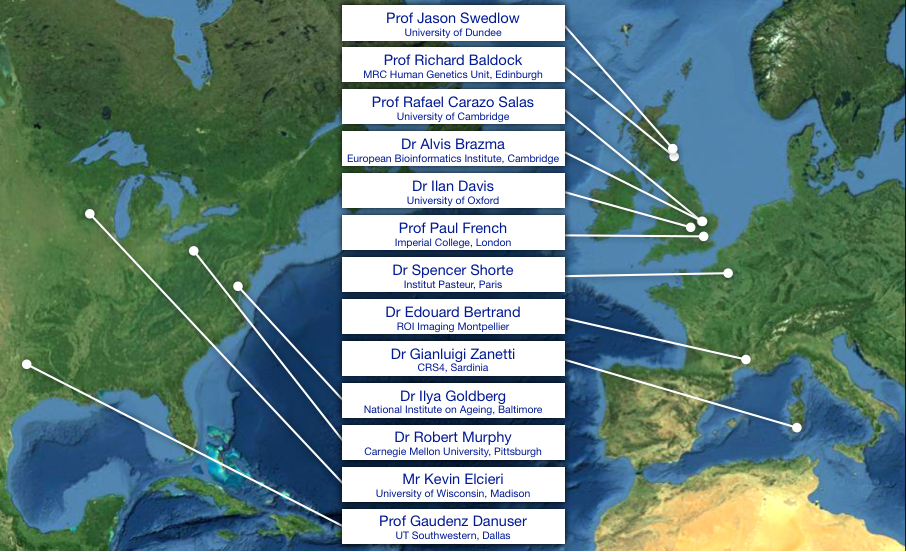The OME Teams
OME - Open Microscopy Environment
The Open Microscopy Environment (OME) is a multi-site collaborative effort among academic laboratories and a number of commercial entities, that produces open tools to support data management for biological light microscopy. Designed to interact with existing commercial software, all OME formats and software are free, and all OME source code is available under the GNU General public license or through commercial license from Glencoe Software.
In 2011 the OME consortium was awarded a Wellcome Trust Strategic Award (Ref: 095931). This Award provided support for the continued development of the OME Data Model, Bio-Formats file translation library and OMERO application in Dundee, as well as funding development positions in nine other laboratories. In 2014, this Strategic Award was extended into 2015. OME's work on extensions of metadata during 2016/2016 are funded by the BBSRC (BB/L024233/1 and BB/G022585/1). The development of the Image Data Resource (IDR) was funded by the BBSRC from 2015-2016 (BB/M018423/1) with continuing funding from two EU Horizon 2020 awards, CORBEL) (Ref: 654248) and Euro-BioImaging Preparatory Phase II (Ref: 688945). OME also participates in two other H2020 projects-- Global BioImaging (Ref: 653493) and MULTMOT (Ref: 634107). OME's work on Bio-Formats is supported by a Wellcome Trust Biomedical Resource Award (Ref: 202908).

Map of OME sites
The OME commercial partner is:
The members of the OME consortium are:
- Prof Jason Swedlow, Wellcome Trust Centre for Gene Regulation & Expression, Dundee
- Prof Richard Baldock, MRC Human Genetics Unit, Edinburgh
- Prof Rafael Carazo Salas, University of Cambridge
- Dr Alvis Brazma, European Bioinformatics Institute, Cambridge
- Dr Edouard Bertrand, ROI Imaging Montpellier
- Prof Gaudenz Danuser, UT Southwestern
- Dr Ilan Davis, University of Oxford
- Mr Kevin Elicieri, University of Wisconsin-Madison
- Prof Paul French, Imperial College London
- Dr Ilya Goldberg, NIA- NIH
- Dr Robert Murphy, Carnegie Mellon University
- Dr Spencer Shorte, Institut Pasteur
- Dr Gianluigi Zanetti, CRS4, Sardinia
The goal of this project is to substantially enhance OME’s resources, OME’s functionality and resources for the Community. The stated aims for the project grant are:
- Extend the functionality and capabilities of Bio-Formats and OMERO adding new data types to Bio-Formats and image processing applications to OMERO;
- Build a network of OME development sites at key locations that have critical applications and algorithm expertise and incorporate this expertise into Bio-Formats and OMERO;
- Apply advanced feature extraction and machine learning to diverse sets of well-annotated data, providing the foundation for automatic annotation of multidimensional image data;
- Build the facilities for publishing data from each OMERO installation, by enabling upload of data directly to the JCB DataViewer and CELL Image Library, either by uploading to these and any other repositories, or by publishing from each installation and making the image data and metadata properly tagged and annotated to drive improvements in search engine technology and make data globally available;
- Build a dedicated support team for the OME community with funding and resources to deliver help with installation and development of applications within the UK scientific community.
Growing The OME Consortium
The idea of catalysing development with OME’s resources at specific locations is not exclusive. The OME Consortium and Wellcome Trust funding are committed to using this expansion as a catalytic event. We aim to use these as the first of many development sites, which are using OME’s tools. In fact this is already the case.
For example OME’s resources are used in:
- KNIME (knime.org)
- Fiji (Fiji.sc)
- Endrov (endrov.net),
- Icy (icy.bioimageanalysis.org)
- XuvTools (www.xuvtools.org),
- Macnification (www.orbicule.com/macnification/),
- CellProfiler (www.cellprofiler.org),
- Bisque (www.bioimage.ucsb.edu/bisque),
- FARSIGHT (www.farsight-toolkit.org),
- i3dcore (cbia.fi.muni.cz/user_dirs/i3dlib_doc/i3dcore/),
- PerkinElmer’s Columbus® (www.perkinelmer.com/pages/020/cellularimaging/products/columbus.xhtml),
-
and many others.
Bitplane’s Imaris (www.bitplane.com) links to Fiji and Bio-Formats.
Places that publish image data with OMERO and Bio-Formats:
- JCBDataViewer (http://jcb-dataviewer.rupress.org/)
- Stowers Data Repository (http://srdr.stowers.org/)
- Griffith University: Microscopy Library Public Collections (http://omero.rcs.griffith.edu.au/webtest/searchmetacatalogue/)
- The Cell: An Image Library (http://cellimagelibrary.org/)
We are collecting names and contacts of sites that are using and/or developing OME’s resources. If you like to be added to this list please contact Wilma Woudenberg w.woudenberg@dundee.ac.uk.


